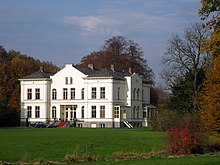
Back Utrecht (provinsie) Afrikaans Provincia d'Utrecht AN مقاطعة أترخت Arabic ܐܘܛܪܝܟܛ (ܗܘܦܪܟܝܐ) ARC مقاطعة اوتريخت ARZ Provincia d'Utrecht AST Utrext əyaləti Azerbaijani Utrecht (propinsi) BAN Утрэхт (правінцыя) Byelorussian Утрэхт (правінцыя) BE-X-OLD
Province of Utrecht
Provincie Utrecht (Dutch) | |
|---|---|
|
| |
| Anthem: Langs de Vecht en d'oude Rijnstroom | |
 Location of Utrecht in the Netherlands | |
 Topography map of Utrecht | |
| Coordinates: 52°6′12″N 5°10′45″E / 52.10333°N 5.17917°E | |
| Country | Netherlands |
| Capital (and largest city) | Utrecht |
| Government | |
| • King's Commissioner | Hans Oosters (PvdA) |
| • Council | Provincial Council of Utrecht |
| Area (2023)[1] | |
• Total | 1,560 km2 (600 sq mi) |
| • Land | 1,484 km2 (573 sq mi) |
| • Water | 76 km2 (29 sq mi) |
| • Rank | 12th |
| Population (1 January 2023)[2] | |
• Total | 1,387,643 |
| • Rank | 5th |
| • Density | 935/km2 (2,420/sq mi) |
| • Rank | 3rd |
| GDP | |
| • Total | €81.305 billion |
| • Per capita | €62,800 |
| ISO 3166 code | NL-UT |
| HDI (2021) | 0.964[4] very high · 1st of 12 |
| Website | www.provincie-utrecht.nl |


Utrecht (Dutch pronunciation: [ˈytrɛxt] ⓘ), officially the Province of Utrecht (Dutch: Provincie Utrecht), is a province of the Netherlands. It is located in the centre of the country, bordering the Eemmeer in the north-east, the province of Gelderland in the east and south-east, the province of South Holland in the west and south-west and the province of North Holland in the north-west and north. The province of Utrecht has a population of about 1,388,000[2] as of January 2023. With a land area of approximately 1,484 square kilometres (573 sq mi), it is the second smallest province in the country. Apart from its eponymous capital, major cities and towns in the province are Amersfoort, Houten, IJsselstein, Nieuwegein, Veenendaal and Zeist. The busiest railway station in the Netherlands, Utrecht Centraal, is located in the province of Utrecht.[5]
- ^ Statistieken provincie Utrecht - Gegevens over meer dan 100 onderwerpen!, AlleCijfers.nl
- ^ a b "CBS StatLine".
- ^ "EU regions by GDP, Eurostat". Retrieved 18 September 2023.
- ^ "Sub-national HDI - Area Database - Global Data Lab". hdi.globaldatalab.org. Retrieved 2018-09-13.
- ^ Gerling, Marco (2019-07-04). "Utrecht Centraal blijft drukste station van Nederland, station Leidsche Rijn groeit het snelst". Algemeen Dagblad. Retrieved 2023-10-28.

